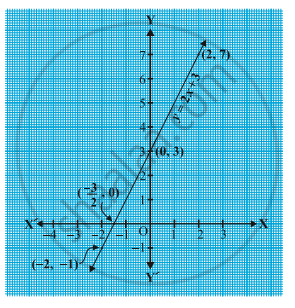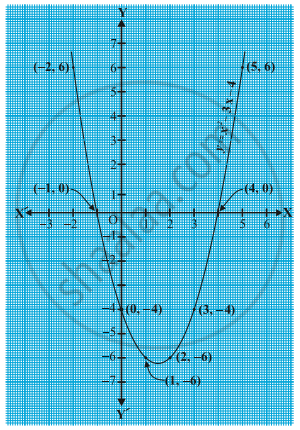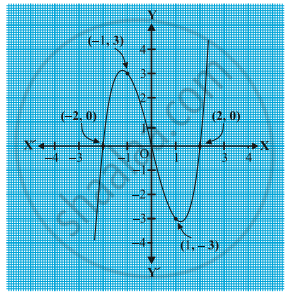Topics
Number Systems
Real Numbers
Algebra
Polynomials
Pair of Linear Equations in Two Variables
- Introduction to linear equations in two variables
- Graphical Method
- Substitution Method
- Elimination Method
- Cross - Multiplication Method
- Equations Reducible to a Pair of Linear Equations in Two Variables
- Consistency of Pair of Linear Equations
- Inconsistency of Pair of Linear Equations
- Algebraic Conditions for Number of Solutions
- Simple Situational Problems
- Pair of Linear Equations in Two Variables
- Relation Between Co-efficient
Quadratic Equations
- Quadratic Equations
- Solutions of Quadratic Equations by Factorization
- Solutions of Quadratic Equations by Completing the Square
- Nature of Roots of a Quadratic Equation
- Relationship Between Discriminant and Nature of Roots
- Situational Problems Based on Quadratic Equations Related to Day to Day Activities to Be Incorporated
- Application of Quadratic Equation
Arithmetic Progressions
Coordinate Geometry
Lines (In Two-dimensions)
Constructions
- Division of a Line Segment
- Construction of Tangents to a Circle
- Constructions Examples and Solutions
Geometry
Triangles
- Similar Figures
- Similarity of Triangles
- Basic Proportionality Theorem (Thales Theorem)
- Criteria for Similarity of Triangles
- Areas of Similar Triangles
- Right-angled Triangles and Pythagoras Property
- Similarity of Triangles
- Application of Pythagoras Theorem in Acute Angle and Obtuse Angle
- Triangles Examples and Solutions
- Concept of Angle Bisector
- Similarity of Triangles
- Ratio of Sides of Triangle
Circles
Trigonometry
Introduction to Trigonometry
- Trigonometry
- Trigonometry
- Trigonometric Ratios
- Trigonometric Ratios and Its Reciprocal
- Trigonometric Ratios of Some Special Angles
- Trigonometric Ratios of Complementary Angles
- Trigonometric Identities
- Proof of Existence
- Relationships Between the Ratios
Trigonometric Identities
Some Applications of Trigonometry
Mensuration
Areas Related to Circles
- Perimeter and Area of a Circle - A Review
- Areas of Sector and Segment of a Circle
- Areas of Combinations of Plane Figures
- Circumference of a Circle
- Area of Circle
Surface Areas and Volumes
- Surface Area of a Combination of Solids
- Volume of a Combination of Solids
- Conversion of Solid from One Shape to Another
- Frustum of a Cone
- Concept of Surface Area, Volume, and Capacity
- Surface Area and Volume of Different Combination of Solid Figures
- Surface Area and Volume of Three Dimensional Figures
Statistics and Probability
Statistics
Probability
Internal Assessment
Notes
1) In a general, given a polynomial p(x) of degree n, the graph of y=p(x) intersects the x-axis at atmost n points. Therefore, a polynomial p(x) of degree n has at most n zeroes.
Example- Consider first a linear polynomial ax + b, a ≠ 0. You have studied in Class IX that the graph of y = ax + b is a straight line. For example, the graph of y = 2x + 3 is a straight line passing through the points (– 2, –1) and (2, 7).

 From Fig. you can see that the graph of y = 2x + 3 intersects the x-axis mid-way between x = –1 and x = – 2,
From Fig. you can see that the graph of y = 2x + 3 intersects the x-axis mid-way between x = –1 and x = – 2,
that is, at the point `(-3/2,0)`
You also know that the zero of
2x + 3 is `-3/2`
Thus, the zero of the polynomial 2x + 3 is the x-coordinate of the point where the graph of y = 2x + 3 intersects the x-axis.
2)Any polynomial of odd degree will never have nil zeroes. Polynomials with odd degree of power will have minimum one 0. Whereas polynomials having even degree of power have minimum zero 0.
Example1- Let us see what the graph of a even polynomial `y = x^2 – 3x – 4` looks like. Let us list a few values of `y = x^2 – 3x – 4` corresponding to a few values for x as given in Table
If we locate the points listed above on a graph paper and draw the graph, it will actually look like the one given in Fig.
In fact, for any quadratic polynomial `ax2 + bx + c,` a ≠ 0, the graph of the corresponding equation y = `ax^2 + bx + c` has one of the two shapes either open upwards like or open
downwards like depending on whether a > 0 or a < 0. (These curves are called parabolas.)
You can see from Table that –1 and 4 are zeroes of the quadratic polynomial. Also note from Fig that –1 and 4 are the x-coordinates of the points where the graph of `y = x2 – 3x – 4 ` intersects the x-axis. Thus, the zeroes of the quadratic polynomial `x^2 – 3x – 4` are x-coordinates of the points where the graph of `y = x^2 – 3x – 4` intersects the x-axis.
Example2- Consider a odd polynomial `x^3 – 4x`. To see what the graph of `y = x^3 – 4x` looks like, let us list a few values of y corresponding to a few values for x as shown in Table 
Locating the points of the table on a graph paper and drawing the graph, we see that the graph of `y = x^3 – 4x` actually looks like the one given in Fig
We see from the table above that – 2, 0 and 2 are zeroes of the cubic polynomial `x^3 – 4x`. Observe that –2, 0 and 2 are, in fact, the x-coordinates of the only points where the graph of `y = x^3 – 4x` intersects the x-axis. Since the curve meets the x-axis in only these 3 points, their x-coordinates are the only zeroes of the polynomial.


